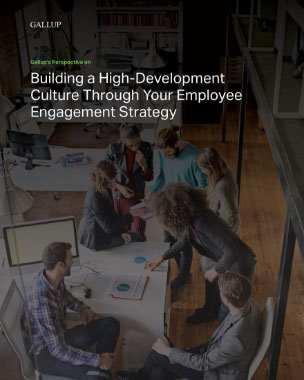Story Highlights
- Though wellbeing dropped to historic lows, engagement continues to climb
- In early May, 38% of employees were engaged and 13% actively disengaged
- Possible explanations include employer COVID-19 response and unemployment
Gallup is closely tracking the engagement and wellbeing of the workforce during this unprecedented time of disruption. We are providing the latest updates for organizational leaders so they can understand the impact on the workplace and what their people need most during this time of rapid change.
Even as Americans' wellbeing has dropped to a 12-year low in the past month amid the coronavirus outbreak, the engagement of the working population has hit a new high.
Gallup found that in early May, the percentage of "engaged" workers in the U.S. -- those who are highly involved in, enthusiastic about and committed to their work and workplace -- reached 38%. This is the highest since Gallup began tracking the metric in 2000.
The percentage of workers who are "actively disengaged" -- those who have miserable work experiences and spread their unhappiness to their colleagues -- tied the 2018 and 2019 low of 13%. This makes the ratio of engaged to actively disengaged workers 2.9-to-1, the highest ever in Gallup tracking. These findings are based on a random sample of 4,724 full- and part-time U.S. employees working for an employer from April 27 to May 17, 2020.

Line graph of U.S. employee engagement trend. 26% were engaged and 18% actively disengaged in 2000. The trend rose and fell by a few points until 2010 when the percentage engaged began to steadily increase to 38%, and actively disengaged decreased to 13%.
The remaining 49% of workers are "not engaged" -- they are psychologically unattached to their work and company. These employees put time, but not energy or passion, into their work. Not engaged employees typically show up to work and contribute the minimum effort required. They're also on the lookout for better employment opportunities and will quickly leave their company for a slightly better offer.
Gallup found that in early May, the percentage of "engaged" workers in the U.S. -- those who are highly involved in, enthusiastic about and committed to their work and workplace -- reached 38%.
At the start of the trend in 2000, 26% of workers were engaged, and 18% were actively disengaged. While there has been a 12-percentage-point increase since 2000, most of the improvement in employee engagement has been in the past decade -- 10 points of the 12-point gain and a 6-point decline in active disengagement.
Why Employee Engagement Is More Important During Tough Times
Historically high employee engagement during the pandemic clearly benefits organizations. The relationship between employee engagement and performance outcomes such as profitability, productivity, customer perceptions and employee turnover has actually been stronger in past recessions, compared with nonrecession years, according to a recent Gallup global meta-analysis of 62,965 business units and teams, published in the organizational science journal Human Performance.
Employee engagement is determined by factors such as feeling clear about your role; having the right materials and equipment to do your job; having the opportunity to do what you do best; having strongly committed coworkers; and working with a common mission or purpose.
Importantly, these are factors that managers can directly influence and that vary in how well they are executed across teams within most organizations.
In short, team members with higher levels of engagement:
- produce substantially better outcomes
- treat customers better and attract new ones
- are more likely to remain with their organization
- are healthier and less likely to experience burnout
Of course, this all raises the question: How is it possible that engagement has reached record highs while wellbeing is crashing during the COVID-19 pandemic?
Employee Engagement, Wellbeing and the Employer Response in Crisis
This is a particularly surprising finding given the well-documented correlation between employee engagement and overall wellbeing. This pandemic and recession have disrupted people's lives in multiple ways -- from stirring fears about health and finances to nearly two-thirds of the population working from home at the pandemic's peak. The lines between work and life are blurred. Stress spiked at record levels, and the percentage of thriving Americans hit 2008-2009 recession lows. Yet engagement has continued to rise.
Even during the coronavirus pandemic, engaged employees, compared with those who are not engaged or actively disengaged, report lower levels of stress and worry and are more likely to report thriving overall lives. Even though wellbeing is falling in aggregate due to the pandemic and recession, engaging work can serve as a buffer that makes lives somewhat better.
Large-scale events like pandemics and recessions don't generally alter macro-level employee engagement -- how organizations respond to the crisis affects engagement more. Here are three factors that might explain the continued uptick of engagement during the coronavirus pandemic:
1. The employer response is improving.
Gallup tracking suggests that employers, from employees' perspectives, have improved in their response to the COVID-19 crisis. While their responses have varied considerably, most organizations have focused on communication: having a clear plan of action, preparing employees to do work in a new context, and ensuring supervisors inform employees of the latest developments related to the pandemic and economic downturn. These responses are statistically linked to higher engagement and are related to whether employees feel their organization cares about their overall wellbeing.
2. The employment base is smaller.
During the pandemic, more than 30 million people have become unemployed and, for now, are not in our employee engagement index pool of respondents. Gallup studied the engagement of a sample of these newly unemployed individuals and their engagement levels in early March when the pandemic began. This group recorded slightly lower engagement than other workers prior to becoming unemployed. If they were still employed and surveyed in April and May, we might have reported a slightly lower percentage of engaged employees.
3. Employees feel fortunate to have work.
Those currently in the workforce likely appreciate their job and might be deeply engaged in making a difference in their organization. They may be reflecting their appreciation in giving more positive responses to the engagement questions. The engagement element that Gallup found improved the most was: I have the materials and equipment I need to do my work right. This element directly reflects organizations' efforts to prepare employees to do work in a new context.
Large-scale events like pandemics and recessions don't generally alter macro-level employee engagement -- how organizations respond to the crisis affects engagement more.
Gallup research indicates that changes in employee engagement are best attributed to organizational practices such as top executive involvement, manager education, communication and accountability. And in the current crisis, these factors are highly related to the employer response.
The coronavirus pandemic has made it abundantly clear that some factors are far outside of employers' control -- but there are many factors that organizations and their managers can control. They can respond in ways that show their employees that they care.
And it's more important than ever that managers are equipped with the right skills to coach their remote-working teams. In the reopening transition phases to come, organizations and managers must put considerable thought into who should continue to work from home and who should return to the workplace.
Get the support you need to create an engaged workplace now and in the next normal:
- Use what Gallup knows about how people and workplaces behave in crisis to effectively lead through COVID-19 disruption.
- Partner with Gallup to find an engagement solution that works for your unique business circumstances.
- Download COVID-19: A Leader's Guide to Developing a Work-From-Home Strategy or attend the webinar for the latest data and insights on remote work.






